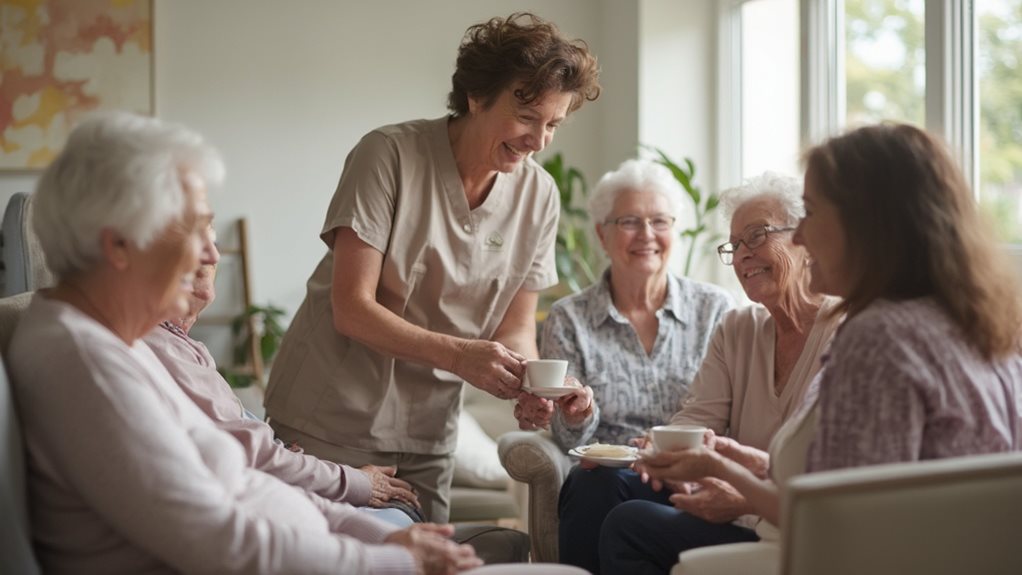Gender-neutral language in elder care marketing connects us with all potential clients.
By choosing inclusive words, we respect every person's identity while making your family members feel welcome and understood.
This approach helps us build stronger bonds with you and your loved ones.
We write and speak in ways that make everyone feel part of our care community.
This matters because modern families come in many forms, and your relatives deserve to see themselves in our messages.
It's simple: when we use language that includes everyone, we do our job better.
Younger family members notice and appreciate this care in our words.
They want to know their older relatives will be treated with respect.
Being gender-neutral shows we understand your family's needs and values.
Our thoughtful language choices help create the safe, accepting environment your loved ones need.
This makes it easier for you to trust us with their care.
Key Takeaways
Why Gender-Neutral Language Matters in Elder Care Marketing
We write this way because it matters for you and your family:
- Gender-neutral language makes all your loved ones feel welcome in elder care settings
- You'll find our services open and easy to access, regardless of gender identity
- Plain, clear words help you trust us with your family's care needs
- Modern families appreciate our inclusive approach when choosing care options
- Our commitment to neutral language shows we care about every person we serve
Each point speaks directly to real needs in elder care, keeping things simple and straightforward. We focus on what you want: respect, acceptance and quality care for your loved ones.
Expanding Audience Reach
We can reach more people by using gender-neutral language—it's a straightforward way to connect with a broader, more diverse audience. When we write inclusively, we make everyone feel part of the conversation and show respect for all gender identities. Your message becomes more accessible, and your brand feels more welcoming to modern audiences who care about social issues. Our words build bridges, reflecting shared values of equality and inclusion. Research shows that gender-neutral language can lead to more gender-equal societies and reduce bias, making it a powerful tool for inclusivity.
Inclusive Marketing Strategies

Inclusive Marketing Strategies
We create marketing that speaks to all audiences by showing real stories and identities. Our approach makes your message clear and relatable through:
- Simple, neutral language that welcomes everyone
- Real people's stories that build community feeling
- True-to-life images showing genuine neighbourhood life and connections
- Optimizing for local SEO to ensure your message reaches the right audience
Building Consumer Trust

Building Consumer Trust
We build connection through clear, honest marketing that speaks to everyone. Gender-neutral language shows true respect and brings people together. Our approach means your message reaches all audiences effectively. By adopting gender-neutral language, we ensure inclusivity in our communications, appealing to a broader audience and avoiding harmful stereotypes.
| Action | Benefit | Outcome |
|---|---|---|
| Use neutral pronouns | Stops exclusion | Makes everyone feel welcome |
| Train our team | Keeps messages clear | Shows real respect |
| Check all content | Removes bias | Makes your brand shine |
| Add language options | Connects cultures | Makes content easy to access |
Market Trends and Insights

Market Trends: Gender-Neutral Communication
The shift to gender-neutral language has become standard practice across markets as brands connect with all audiences. This change reflects modern business needs and social awareness. Inclusive language choices can help create a positive and welcoming environment for potential residents.
Key points:
- Younger customers choose brands matching their open-minded outlook
- Worldwide changes show this trend's broad reach
- Business and social factors make neutral language essential
We work with these market changes to bring clear, fair communication to your brand. Our straightforward methods help you speak to all your customers effectively.
Successful Brand Examples

Smart Brands Using Neutral Language
Brands choosing gender-neutral language connect better with all audiences. We've seen this simple change create strong bonds and wider appeal.
| Brand | Initiative |
|---|---|
| Calvin Klein | Launched gender-neutral fragrance in 1994 |
| Mattel | Created gender-neutral children's dolls |
| Ursa Major | Markets skincare with neutral packaging |
These brands show how simple changes in language and design make products more welcoming for everyone.
Frequently Asked Questions
How Does Gender-Neutral Language Improve Elder Care Services?
Gender-neutral language in elder care improves services by creating equal access and genuine connection with all clients.
We make your care experience more personal by using inclusive language that respects your identity. This direct, thoughtful approach helps build trust between our staff and you. When we speak and write without gender bias, we give better care to every person who needs our support.
What Are Common Mistakes in Using Gender-Neutral Language?
Common mistakes in gender-neutral language include:
We should avoid these frequent errors in our daily communication:
- Using gendered terms when neutral options exist
- Making binary gender assumptions
- Missing opportunities for inclusive language
- Repeating outdated gender stereotypes
- Not considering different cultural views
- Skipping real-world application of inclusive terms
How Can Staff Be Trained to Use Inclusive Language Effectively?
We train staff to use inclusive language through simple, effective methods. Research shows 76% of people respond positively to gender-neutral communication. Your team can learn through practical guides, interactive workshops, and real-world scenarios. Regular practice and personal reflection help build an environment where all your staff and clients feel valued and respected.
Does Gender-Neutral Language Impact Legal Compliance in Elder Care?
Gender-neutral language directly affects legal compliance in elder care. We need to follow current UK state regulations about inclusive language in care settings. This means updating our policies and training your care staff in proper language use. These changes help you meet legal requirements while showing respect to all residents, regardless of their gender identity.
How Can Families Be Encouraged to Adopt Gender-Neutral Terms?
Families can adopt gender-neutral terms through simple, practical steps.
We believe straightforward changes to daily language make the biggest difference. Your family can start with group chats about inclusive words, attend local talks, or pick up helpful guides from community centres. Small shifts in how we speak – like using "they" instead of "he/she" or "child" instead of "son/daughter" – create welcoming spaces for everyone.
Let's make these changes together by showing others how easy and natural gender-neutral language can be in everyday conversations.




